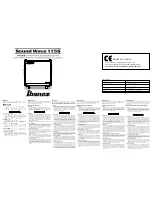
50
Basics
Chapter 2
SR860 DSP Lock-in Amplifier
The Input Amplifier
A lock-in can measure signals as small as a few nanovolts. A low noise signal amplifier
is required to boost the signal to a level where the A/D converter can digitize the signal
without degrading the signal to noise. The analog gain in the SR860 ranges from roughly
1 to 100. As discussed previously, higher gains do not improve signal to noise and are not
necessary. The gain is set by the Input Range.
What is the Noise Floor?
The input noise of the SR860 signal amplifier is about 2.5 nVrms/
√Hz. What does this
noise figure mean? Let's set up an experiment. If the SR860’s Input Range is set to
10 mV then the input gain is sufficient that the noise floor of the measurement is
determined by the input noise. Suppose the PSD output is low pass filtered with a single
RC filter (6 dB/oct roll off) with a time constant of 100 ms. What will be the noise floor
of the measurement?
Amplifier input noise and Johnson noise of resistors are Gaussian in nature. That is, the
amount of noise is proportional to the square root of the bandwidth in which the noise is
measured. A single stage RC filter has an equivalent noise bandwidth (ENBW) of 1/(4T)
where T is the time constant (R×C). This means that Gaussian noise is filtered with an
effective bandwidth equal to the ENBW. In this example, a single 100ms low-pass filter
has an ENBW of 1/(4×100ms) or 2.5 Hz. Thus the lock-in noise floor will be
2.5 nVrms/
√Hz
×
√2.5Hz or
~4 nVrms. For Gaussian noise, the peak to peak noise is
about 5 times the rms noise. Thus, the output will have about 20 nV pk–pk of noise.
Remember that the SR860 reports its measurements in Volts referred to the input BNC.
In this case, the SR860 will appear to have 20 nV pk–pk of noise at f
ref
at the input, with
its input grounded and no signal even applied. If this noise floor is too large for your
experiment, then you need to add more filter stages or increase the time constant to
decrease the ENBW.
All of this assumes that the signal input is being driven from a low impedance source.
Remember resistors have Johnson noise equal to 0.13×
√R
nVrms/
√Hz. Even a 50Ω
resistor has almost 1 nVrms/
√Hz of noise
. A signal source impedance of 400
Ω will have
a Johnson noise greater than the SR860's input noise. To determine the overall noise of
multiple noise sources, take the square root of the sum of the squares of the individual
noise figures. For example, if a 400
Ω source impedance is us
ed its Johnson noise will be
2.6 nVrms/
√Hz. The overall noise a
t the SR860 input will be [(2.6)
2
+ (2.5)
2
]
1/2
or
3.6 nVrms/
√Hz.
We'll talk more about noise sources later in this section.
At lower gains (Input Ranges above 10 mV), there is not enough gain to amplify the
input noise to a level greater than the noise of the A/D converter. In these cases, the
apparent input noise increases with the Input Range. For example, the configuration
above will appear to have 30 nV pk–pk noise at the input when the Input Range is set to
100 mV and 250 nV pk–pk when the Input Range is 1 V. This means that even with 1 V
of interfering noise, the SR860 can measure f
ref
signals below 1 μV by increasing the
amount of low pass filtering.
Summary of Contents for SR860
Page 1: ...Revision 2 01 Operation Manual SR860 500 kHz DSP Lock in Amplifier ...
Page 5: ...Safety and Preparation For Use iii SR860 DSP Lock in Amplifier ...
Page 6: ...iv Safety and Preparation For Use SR860 DSP Lock in Amplifier ...
Page 54: ...36 Getting Started Chapter 1 SR860 DSP Lock in Amplifier ...
Page 118: ......
Page 172: ......
Page 186: ...168 The FFT Display Appendix B SR860 DSP Lock in Amplifier ...
Page 192: ......
















































